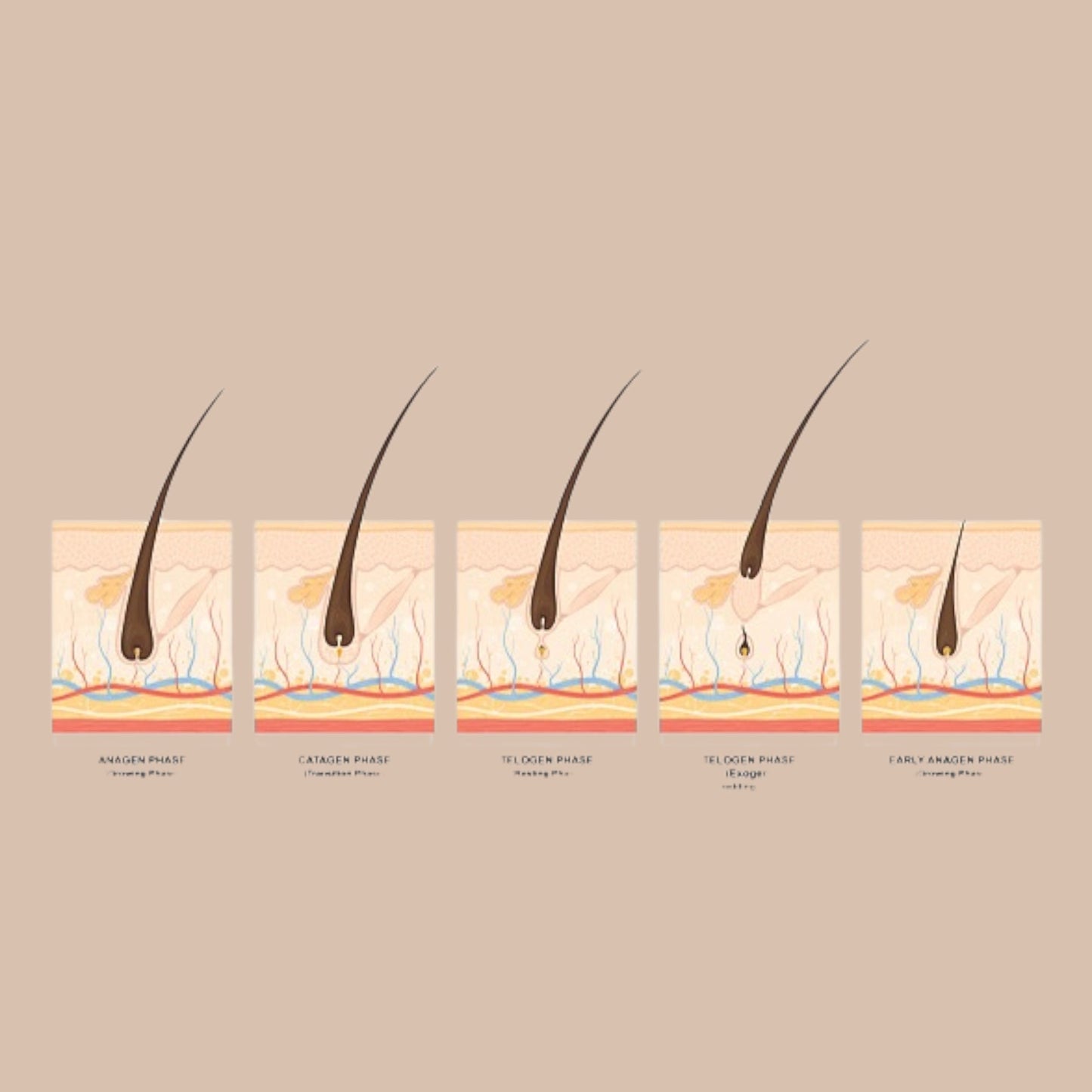
Hair growth is a continuous cycle that follows four distinct stages: Anagen, Catagen, Telogen, and Exogen. Each strand of hair on your scalp is at a different stage of this cycle, which ensures that you don’t lose all your hair at once. Understanding these stages is key to maintaining healthy hair growth and recognizing conditions like excessive shedding or hair loss.
1. Anagen (The Growth Phase)
The anagen phase is the most important stage for hair growth. During this phase:
✔ Hair follicles are actively producing new hair cells.
✔ The hair grows about 1 cm per month.
✔ The length of this phase determines how long your hair can grow.
✔ 85-90% of your hair is in this phase at any given time.
How Long Does the Anagen Phase Last?
-
Scalp Hair: 2 to 7 years (varies by genetics).
-
Eyelashes & Eyebrows: 30 to 45 days (which is why they stay shorter).
How to Support Hair Growth During Anagen
-
Eat a nutrient-rich diet with biotin, vitamins A, B6, B12, C, D, E, K, and folic acid—all found in Laura Simmons Bition Gummies.
-
Use gentle, sulfate-free shampoos and conditioners like Laura Simmons Sandalwood Shampoo & Conditioner to keep the scalp healthy and hydrated.
-
Avoid excessive heat styling and harsh chemicals that can weaken hair.
2. Catagen (The Transition Phase)
The catagen phase is a short transitional stage that prepares the hair follicle to stop growing. During this phase:
✔ Hair follicles shrink, and growth slows down.
✔ The hair detaches from the blood supply but remains in place.
✔ Only about 1% of hair is in this phase at any given time.
How Long Does the Catagen Phase Last?
-
2 to 3 weeks.
Why This Phase Matters
Since the hair is no longer growing, it’s more fragile and can be easily damaged. This is why proper scalp care and hydration are essential during all stages.
3. Telogen (The Resting Phase)
In the telogen phase, hair is in a resting state before shedding. During this phase:
✔ The hair is fully formed but no longer growing.
✔ The follicle remains inactive, preparing for the next cycle.
✔ Around 10-15% of hairs are in this phase at any given time.
How Long Does the Telogen Phase Last?
-
2 to 3 months.
Why This Phase is Important
If more hairs than usual enter this phase at once, it can lead to excessive shedding, a condition known as telogen effluvium. This can be triggered by stress, poor diet, illness, or hormonal changes.
4. Exogen (The Shedding Phase) & Early Anagen
The exogen phase is an extension of the telogen phase, where old hairs are shed to make way for new growth.
✔ Shedding 50-100 hairs per day is normal.
✔ Some people experience more shedding due to seasonal changes, stress, or scalp conditions.
✔ The follicle then re-enters the anagen phase, specifically early anagen, to grow new hair.
Exogen vs. Early Anagen
-
Exogen is when the hair actively sheds from the follicle.
-
Early anagen (also called Anagen Phase 1) immediately follows exogen, where the hair follicle begins to produce a new hair strand.
This transition ensures that your scalp is constantly regenerating new hair, which is why maintaining scalp health is crucial.
How to Minimize Excessive Shedding
-
Maintain a healthy diet to support new hair growth.
-
Use hydrating and nourishing products like Laura Simmons Sandalwood Shampoo & Conditioner to maintain scalp balance.
-
Take Bition Gummies to ensure your body gets the right nutrients for strong hair regrowth.
Final Thoughts: How to Maintain a Healthy Hair Growth Cycle
Healthy hair growth depends on good nutrition, scalp health, and a balanced lifestyle. To keep your hair in optimal condition:
✔ Eat a nutrient-rich diet with vitamins and minerals that support hair follicles.
✔ Use gentle, hydrating hair care products to maintain scalp health.
✔ Reduce stress to prevent excessive shedding.
✔ Take targeted supplements like Bition Gummies to support hair growth from within.
By understanding the four stages of hair growth, you can take the right steps to nourish your scalp, minimize hair loss, and promote strong, healthy hair.
